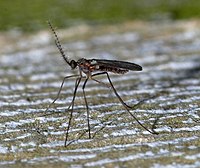
Differential development time of galls induced by Leptocybe invasa (Hymenoptera: Eulophidae) reveal differences in susceptibility between two Eucalyptus clones.
Sign Up to like & getrecommendations! Published in 2020 at "Pest management science"
DOI: 10.1002/ps.6119
Abstract: BACKGROUND The significance of morphological responses of hosts on susceptibility against gall-inducing insects are relatively unknown specially in planted forests. Here, we investigate the temporal morphological responses (gall development) induced by the invasive gall wasp… read more here.
Keywords: susceptibility; leptocybe invasa; time; eucalyptus clones ... See more keywords

Neovascularization during leafy gall formation on Arabidopsis thaliana upon Rhodococcus fascians infection
Sign Up to like & getrecommendations! Published in 2017 at "Planta"
DOI: 10.1007/s00425-017-2778-5
Abstract: AbstractMain conclusionExtensive de novo vascularization of leafy galls emerging uponRhodococcus fasciansinfection is achieved by fascicular/interfascicular cambium activity and transdifferentiation of parenchyma cells correlated with increased auxin signaling. A leafy gall consisting of fully developed yet… read more here.
Keywords: arabidopsis thaliana; leafy gall; rhodococcus fascians; formation ... See more keywords

Metabolic and functional distinction of the Smicronyx sp. galls on Cuscuta campestris
Sign Up to like & getrecommendations! Published in 2018 at "Planta"
DOI: 10.1007/s00425-018-2926-6
Abstract: Main conclusionThe weevil gall contains two distinct regions, differing in hydrolytic and antioxidant enzymes activity and profiles, which is also functionally distinct from the non-infected Cuscuta stems.Weevils of the genus Smicronyx are gall-forming insects, widely… read more here.
Keywords: cuscuta campestris; metabolic functional; smicronyx galls; gall ... See more keywords

Ophelimus sp., a new invasive gall wasp of Eucalyptus globulus in Europe, escapes the parasitism by Closterocerus chamaeleon due to an asynchronous life cycle
Sign Up to like & getrecommendations! Published in 2019 at "Biological Control"
DOI: 10.1016/j.biocontrol.2018.12.006
Abstract: Abstract Ophelimus sp. (Hym: Eulophidae) is an Australian gall wasp newly found in Southern Europe forming galls on Eucalyptus globulus. A congeneric gall wasp O. maskelli, also established in the Mediterranean Basin, is currently controlled… read more here.
Keywords: gall; chamaeleon; eucalyptus globulus; gall wasp ... See more keywords

Antimicrobial diterpene induced by two gall-inducing adelgids coexisting on Picea koraiensis.
Sign Up to like & getrecommendations! Published in 2022 at "Tree physiology"
DOI: 10.1093/treephys/tpac041
Abstract: The mechanism by which closely-related species can coexist is a central factor in the stability of ecological communities. The larch adelgid (Adelges laricis laricis) and the eastern spruce adelgid (Adelges (Sacchiphantes) abietis) have both been… read more here.
Keywords: insects; two gall; gall; gall inducing ... See more keywords

The gall wasp Leptocybe invasa (Hymenoptera: Eulophidae) stimulates different chemical and phytohormone responses in two Eucalyptus varieties that vary in susceptibility to galling
Sign Up to like & getrecommendations! Published in 2017 at "Tree Physiology"
DOI: 10.1093/treephys/tpx098
Abstract: Gall-inducing insects produce various types of galls on plants, but little is known about the gall-induction mechanism of these galling insects. The gall wasp Leptocybe invasa Fisher & LaSalle (Hymenoptera: Eulophidae) forms galls of different… read more here.
Keywords: insects; susceptibility; leptocybe invasa; gall wasp ... See more keywords

Integrative taxonomy, larval biology and functional morphology of the little known gall-forming coral endoparasite Petrarca (Thecostraca: Ascothoracida)
Sign Up to like & getrecommendations! Published in 2023 at "Zoological Journal of the Linnean Society"
DOI: 10.1093/zoolinnean/zlad009
Abstract: Petrarca is an ascothoracidan endoparasite in scleratinian dendrophyllid corals. Petrarca can stimulate coral growth, forming a gall chamber to house itself inside the coral skeleton. The diversity, molecular phylogeny and feeding ecology of Petrarca are… read more here.
Keywords: integrative taxonomy; petrarca; gall; functional morphology ... See more keywords

Xanthomonas bonasiae sp. nov. and Xanthomonas youngii sp. nov., isolated from crown gall tissues.
Sign Up to like & getrecommendations! Published in 2022 at "International journal of systematic and evolutionary microbiology"
DOI: 10.1099/ijsem.0.005418
Abstract: The genus Xanthomonas contains a set of diverse bacterial strains, most of which are known for their pathogenicity on annual crops and fruit trees causing economically important plant diseases. Recently, five Xanthomonas strains were isolated… read more here.
Keywords: xanthomonas youngii; bonasiae nov; gall; gall tissues ... See more keywords

Sensory co‐evolution: The sex attractant of a gall‐making fly primes plant defences, but female flies recognize resulting changes in host‐plant quality
Sign Up to like & getrecommendations! Published in 2020 at "Journal of Ecology"
DOI: 10.1111/1365-2745.13447
Abstract: Tall goldenrod plants Solidago altissima appear to eavesdrop on the communication of a specialist gall‐inducing fly Eurosta solidaginis by detecting the volatile emissions of male flies and priming anti‐herbivore defences. However, the effects of defence… read more here.
Keywords: gall; plant quality; plant; host plant ... See more keywords

Gall mite Fragariocoptes setiger (Eriophyoidea) changes leaf developmental program and regulates gene expression in the leaf tissues of Fragaria viridis (Rosaceae)
Sign Up to like & getrecommendations! Published in 2018 at "Annals of Applied Biology"
DOI: 10.1111/aab.12399
Abstract: The interaction of plants with certain types of parasites leads to the formation of galls, organised structures that create the habitat of the parasite, caused by an abnormal proliferation of host plant’s cells under the… read more here.
Keywords: gall; mite fragariocoptes; expression; gene expression ... See more keywords

First steps towards biological control of the pear gall midge (Contarinia pyrivora) with the insect pathogenic fungus Metarhizium brunneum
Sign Up to like & getrecommendations! Published in 2020 at "Journal of Applied Entomology"
DOI: 10.1111/jen.12810
Abstract: Gall midges are important pests in many crops. In fruit, they are difficult to control due to their life cycle, which takes place partially within the fruit. Here, we provide the first successful laboratory experiment… read more here.
Keywords: midge contarinia; fungus; gall; pear gall ... See more keywords